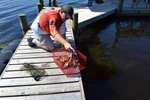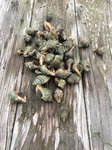FORT MORGAN — On Little Lagoon, gardening takes place by the sea.This summer, more than 50 residents will head out each week to monitor their oyster gardens, copper-colored cages suspended from …
This item is available in full to subscribers.
Please log in to continue |



FORT MORGAN — On Little Lagoon, gardening takes place by the sea.
This summer, more than 50 residents will head out each week to monitor their oyster gardens, copper-colored cages suspended from the decks and piers that linger over the lagoon.
There is no digging or pruning. Rather, these deep-sea green thumbs will gently shake those cages to push predators away from the spat, the over-the-top-adorable name for baby oysters, that arrive at the lagoon measuring no larger than a pencil eraser.
As the tiny oysters mature, they will eventually outgrow their undersea nursery. The gardeners will divide the oysters, spreading them among four floating cages. As the summer drags into fall, they check each week to make sure the oysters are thriving and that predators, like the oyster drill snail, are unable to climb along pilings to access the defenseless creatures.
The unique program isn't just a cool hobby. It's literally changing the water these gardeners live by for the better.
The Little Lagoon Preservation Society has carried the banner of promoting a healthy watershed for the last 12 years. Volunteers work with students, scientists, government officials and private business leaders to inform, educate and energize them in regard to the Little Lagoon environment and the organization's efforts to continually improve it.
In 2017, volunteers with the Little Lagoon Preservation Society dropped their first oyster gardens into the dark waters near their homes. The cages were filled with spat and shells ready for them to attach to. Just 23 gardens that year produced 25,228 oysters despite two tropical weather events and 20 inches of rainfall, both of which had the potential to destroy the crop.
The next year, the program doubled in size and 43 gardens produced 46,631 oysters. In 2022, students from Gulf Shores High School helped care for the spat and monitored 18 of the program's cages. The students raised 7,949 oysters while 57,013 total oysters were grown in the lagoon that year.
Each creature can filter up to 50 gallons of water a day, quickly earning their keep in this garden under the sea.
"All these oysters are helping to clean the lagoon," project coordinator Laurie Eberly said. "To be part of this feels really good."
This year's crop of spat will arrive with an additional mission. Currently, scientists are exposing them to the hormones of their common predators. Scientists hope that early introduction will encourage the spat to grow thicker shells once they are placed in the lagoon. That, scientists hope, would defend them against crabs and oyster drill snails that can devour a cage full of oysters in a matter of days.
When the spat have graduated to full-size oysters, usually in early November or December, they will be moved by the Auburn Shellfish Lab staff to closed reefs in Mobile Bay where they, hopefully, will create their own spat and the reef will continue to grow.
Back on land, gardeners will wave goodbye and wait patiently for their next undersea charges.
"This is just so beneficial to the lagoon and to the environment," Eberly said. "We're very excited to be able to participate."